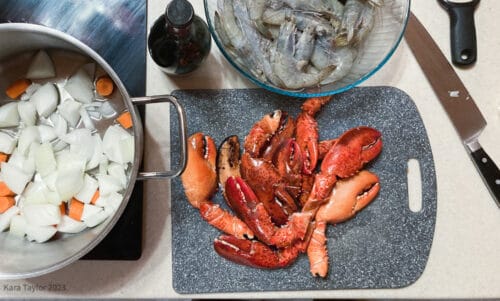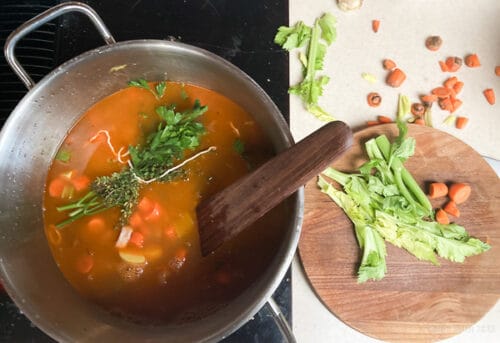Description
This hearty stew is loaded with a variety of fresh seafood and vegetables and served in a rich made-from-scratch bisque. This is not an easy or mess-free recipe but it is 100% worth the effort especially if you enjoy weekend-long kitchen projects. This recipe makes about 2 quarts and serves 4 as a meal and 8 as an appetizer/light meal.
Ingredients
For Day 1 Prep:
1 1/2 lbs head-on shrimp, peeled and deveined and cut into bite-sized pieces, with shells and heads set aside
1 1/2 lb whole cooked lobster, meat removed with body and shells set aside
1 small onion, quartered
2 medium carrots, peeled and broken into large pieces
1/3 cup brandy or sherry
6 cups water/ reserved lobster juices
1 teaspoon salt (plus more to taste if needed)
pinch of saffron (optional)
1 Tablespoon tomato paste
1/2 teaspoon paprika
For the Stew (Day 2)
3 celery stalks
1/3 cup room temperature butter
1/3 cup flour
1 cup heavy cream
1/2 lb whole squid, cleaned and cut into bite-sized pieces
12 oz firm (not flakey) fish fillet, diced into bite-sized pieces about 1/2 inch
3/4 lb carrots, peeled and cut into 1/2 inch pieces.
3/4 lb Yukon Gold potatoes, cut into 1/2-inch peices
2–3 Tablespoons of neutral oil for sauteing
Instructions
Day 1, Prep the Seafood Broth
In a large deep frying pan or brazier, add 1 T oil or butter, the quartered onion, and large carrot pieces and begin to sauté over high heat until the onions are fragrant about 5 minutes.
Add the lobster and shrimp shells and sauté for another 5 minutes or until the shrimp shells turn pink and any water in the pot is gone.

Add the brandy (or sherry) and light the pot on fire to flambé (see note). When the flames subside, add the water, salt, spices, and tomato paste and bring the pan up to a boil. Reduce to the heat, cover, and simmer for about 1 hour.
Remove the broth from the heat and strain it through a fine mesh sieve and transfer it to a storage container (ideally a tall and narrow container instead of a wide and flat one). Cool this broth to room temperature and then transfer it to the refrigerator overnight.
Day 2, Make the Stew
If you haven’t already done so, dice the carrots, potatoes, celery, fish, shrimp, and calamari.

Make a “buerre manie” (an uncooked roux that will be used to thicken the stew) by stirring together the room-temperature butter and the flour until evenly incorporated. Set aside for later.
Add 1 Tablespoon of oil to a 4-6 quart soup pot and heat over medium-low heat. Add the calamari (see note) and sauté for about 15 minutes. Then add the carrots, celery, and potato and sauté over medium-low heat for another 10 minutes. Add the broth and bring the soup up to a boil then reduce the heat to a simmer.

When the vegetables are just tender, probably another 5-10 minutes after the broth comes to a boil, add the buerre manie tablespoon by tablespoon, stirring briskly to dissolve and thicken the soup. Add the heavy cream and bring the pot of soup back to a boil. Taste the broth and add salt and pepper if needed. Then add the remaining raw seafood and cook for 2-3 minutes or until completely opaque. Lastly, stir in the cooked lobster meat. Serve and enjoy.
Notes
To Cook a Live Lobster:
You can buy cooked lobsters from the seafood counter or frozen section of the store for this recipe, but if you live somewhere where live lobsters are available, that is definitely your best option. If you are buying r lobster, place 1 inch of water in a large pot and bring it to a boil. Humanely kill the lobster by either placing it in the freezer for about 10 minutes or driving a knife through its head, between the eyes. Andrew Zimmerman Cooks: How to Kill a Lobster is a good how-to video on dispatching lobsters by Andrew Zimmerman. Once the lobster is dead and the water is at a rapid boil, add the lobster to the pot and cover. Listen carefully for when it returns to a boil. Once boiling, set a timer and steam the lobster for 7 minutes per pound, 10 minutes for 1 1/2 pound lobsters. Run the lobster under cold water or plunge into an ice bath to stop the cooking. You can cook up to 3-4 lobsters in a large pot (5 Gallon) but never try to cook more than that in one pot. Calculated the cooking time based on the average size of the lobsters in the pot, not the total poundage in the pot. For instance, a pot with two 1 1/2 lb lobsters should cook for 10 minutes 30 seconds after the boil returns (1 1/2 lbs x 7 minutes), not 21 minutes (3lbs x 7 minutes).
To Clean the Lobster:
Have a medium bowl handy. Working over the bowl, remove the legs, claws and tail from the body. Lobstery water will likely gush out when you are separating the bits and you will use this in the broth. Using a nut cracker or a hammer and cutting board, crack the shells and remove the meat. Set the meat aside.
Take the body and open it up, separating the shell from the underside where the legs connected. There will be some yellow/green/blackish stuff in the cavity and some red roe (eggs) if you are lucky. Use a spoon and scrape these guts into the bowl with a spoon. This may sound and look nasty but it is really delicious and it is the secret to the best bisque ever.
After removing the guts, pick out the meat from the body. There is actually quite a bit in there and most people waste it when eating lobsters. At the location where each leg connects to the lobster there is a cavity filled with bite-sized pieces of lobster meat. You may need to break apart the cartilage-like pieces that separate these pieces of meat in order to to get to it but you can easily do that with your hands.
When you are done you should have 3 bowls, one with lobster juices, one with meat, and one with shell (including the little legs and body scraps).
Use this same technique for crab.
To Flambé:
If catching something on fire in your kitchen makes you nervous, you can omit this step and simply deglaze the pot with brandy or sherry.
If you want to try this technique out, make sure there is ample space above the stove (without kitchen towels hanging or kitchen cabinets that could catch fire). Use a long-handle grill lighter or light a long wooden skewer on fire and then touch the flame to the booze in the pot. If you have a powerful commercial-grade gas stove, you may be able to just give the pan a little shake and catch it on fire from the burner flames. But if you are using an electric, induction, or average residential gas stove you will need to manually ignite the booze. Brandy will flame up better and last longer than sherry. The booze will pool in the lobster shells and curves of the onion pieces. Those are good places to light. You will want to light the alcohol as soon as you pour it into the pan before it is diluted by any liquid in the pan or the alcohol cooks away so make sure you have everything nearby and ready before you add it. It’s always a good idea to keep a tight-fitting lid nearby in case anything gets out of hand and you need to cover and extinguish the flames. You’ll be using the lid in the next step anyway. All that being said, this is a small amount of alcohol, and it won’t flame up very high or last more than a couple of seconds.
Cooking Calamari
For tender calamari, you can either cook calamari low and slow or quickly for just a few seconds. Anything in the middle will be tough and chewy. For this soup, I use the low-and-slow method for tender calamari. It needs to cook for a total time of 30-45 minutes.
